-
Posts
1,728 -
Joined
-
Last visited
Content Type
Profiles
Forums
Store
Help Articles
Posts posted by Blether
-
-
All right, Rona, I'll put you at the top of the list. In the meantime, can you make do with having a Bob Seger reference in the write-up ?
Helenjp... and is your source a secret ?

-
Have yuki jirushi changed so much ? I haven't noticed and their butter packs look the same as ever (though now more evil. Yuki-jirushi. Grrr). I don't see much change at their web site either.
-
Please send me one of each pie, and I will test them for you...
Ha ha ! Will the cool-bin guys come quickly enough to catch some ? Maybe you should just come & help with the next batch

Ueno's not so far away, I could try Ameyokocho. Thanks for the tip. Have I missed another eG pork pie topic from my list ?
-
We've been having a mini sanma-matsuri: shioyaki and served with Yamasa's konbu ponzu. My better half hadn't known that there was anything to sanma other than a straight grilling and eternal daikon / soy, and pronounced salted sanma by itself 'so delicious'.
This week Hanamasa came up with nama-aki-sake at under 1000yen per side - half became luscious fishcakes - already polished off - and the other half won't likely be in the freezer much past this weekend. Meanwhile I've been eyeing some beautoful-looking herring and plotting rollmops with potato salad, while it's still warm.
-
That is sad. His TV shows were so entertaining.
-
There is "chuu-riki" or "medium" flour...
Ooh, I hadn't ever noticed that, though I think I've seen 'udon flour'. Hi, Helen.
I've gone on enough about Hanamasa. I'd be lost without my local one - though funnily enough they got into fresh lamb in a big way - was it last year ? - only to get out of it again in under 6 months. Nisshin World Deli at Azabu Juban has expanded its fresh & frozen lamb offerings - they are my current pick for this exotic meat (and it's really really lamb, though they no longer carry exactly the frozen legs I used to like. They do still have whole legs, but another brand, and the bone below the 'knee' is gone; they've added another line in 'Easy Carve' legs, which to me are a waste of freezer space).
I keep a 1kg bag on hand of each of Hanamasa's strong flour (14% protein, the label says) and higher-quality weak flour / 薄力一等粉 (8% protein), if for no other reason than I don't want to wrestle with a 5kg flour sack every time I want an ounce or two.
I seem often to be writing on eG about buying flour in bulk from Hokkaido's Ebetsu Flour Mills via Shikisai ・ 四季采 - I like Minorinooka for pizza, Haruyutaka and Zenryuko separately or together for bread. Recently I'm even leaning towards Haruyutaka for pizza. I'm still experimenting with what works best for pastry, but in general I'm mixing some cake flour into one of the strong ones: 1/3 to 2/3 for shortcrust, and I'm going for 50/50 for the next hot water crust. The old bag, sorry I mean my dear old mum used to be famous for her choux, but I just ain't that fancy.
When I was first using the Haruyutaka, I remember having read that it was 11% gluten - strong but not that strong - and lamenting the non-availability of flour specifically labelled as northern climate hard wheat, or otherwise with a good high gluten percentage. Some time later I read through Sikisai's site in detail again and saw Haruyutaka listed as 14% gluten. I was confused. Minorinooka has a bit lower gluten, I don't remember what now.
-
I came across Syrian Beetroot & Yoghurt Dip (photo & commentary just past halfway down) for the first time, only yesterday.
That's a good blog, too - the man really knows how to take pictures and how to work with wood, as well as how to cook.
-
Well, the M looks to me like the cat that got the cream

It's clean and modern, isn't it, compared to the old italic serif font ? But it's still basically the word 'Meiji', unadorned in red. Revolutionary cange from a big Japanese company now that would have been a surprise

-
I'm posting here to add my admiration for fatmat's pie, and to point out my own recent effort in the generic Cooking forum to any readers who concentrate on the UK & Ireland space: Blether's effort
-

The baking paper stayed on some - it eased its way up and off others as they baked. The pie in the centre features a lid made of too-often re-rolled pastry.
You can also see 'wings' developing from the sides in many places. That's because of forming the shells from a larger disc of pastry, that had to be folded into the pastry-cutter I used as a pie form. I didn't use milk or egg inside the folds to help them unify. In the midst of my hot-water crust enthusiasm, I also made up some scotch mutton pies (picture lower down), using some of the egg wash to seal the folds, and those shells baked completely smooth.
No such problems with the large pie:
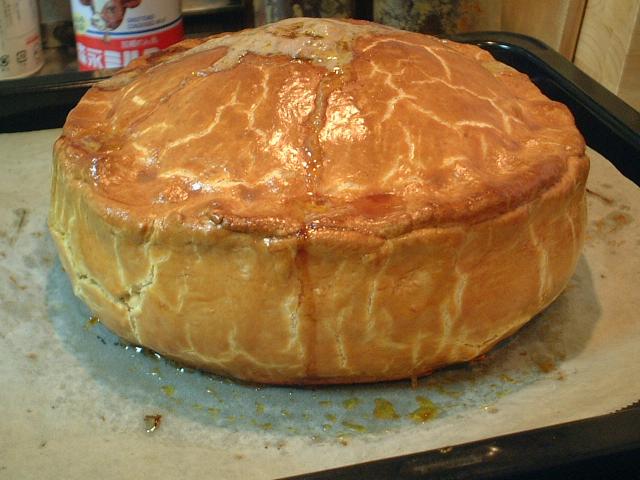
Mmm.
In the whole pie-making process, I had most trouble with the trotter jelly / aspic. It was my first attempt. For the life of me, I could not get it clarified very well, despite two attempts at clarifying with egg whites, the second one after really reading the procedure thoroughly. In the end I got some clarity, seasoned it off with some fish sauce and was satisfied (I chuckled wistfully at Elizabeth David's picture of two kitchen chairs, one upside down on top of the other with a teatowel fastened between the legs). My jelly came out very thick - my best guess is that I used far too little water to cook it. Next time I'll take that improvement as a starting point: I'd appreciate any advice anyone has on trotter jelly and clarifying. I want to make jelly like this:
(Thanks to
Wood-Fired! for this photo)But I diluted the jelly I had a little and filled the pies with it - no pictures, but in inconsistent light, the finished article:

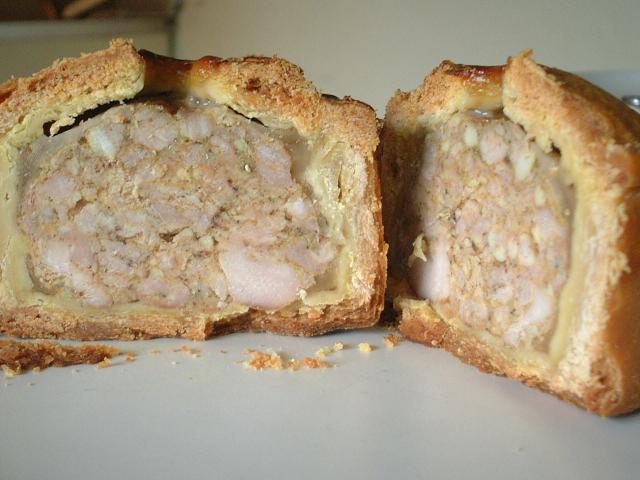
I wouldn't bother again with the cubes of loin - they ended up as rather dry, solid interruptions in an otherwise lush filling. My plan for next time is 50/50 belly and shoulder meat, with perhaps some of the shoulder in cubes nearer to 1/2" than 1". The spice mix was excellent - I judged it both authentic and delicious

Shared with friends who were kind enough to lay on some pickles:
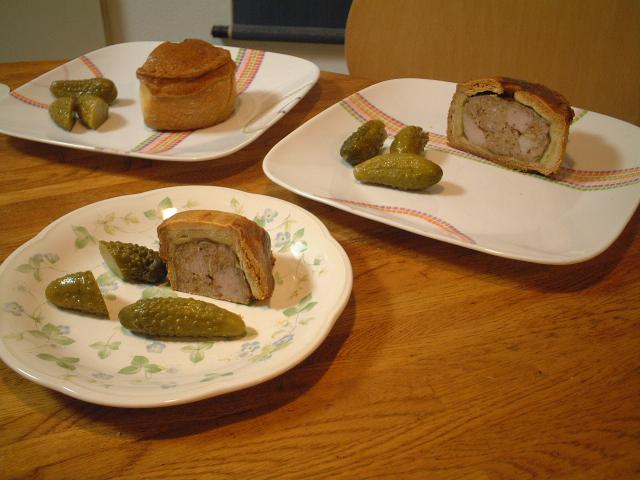
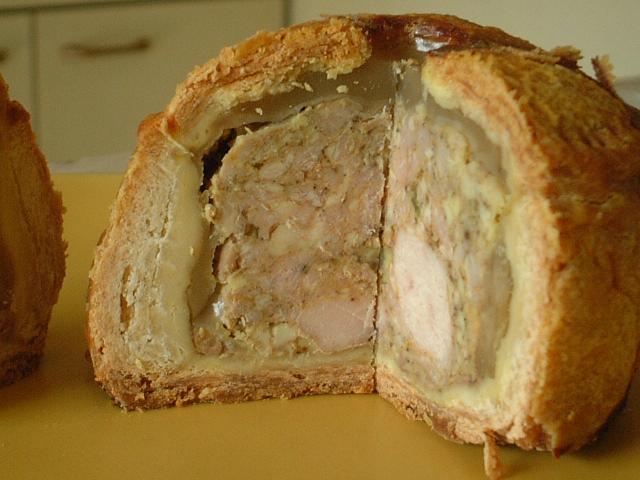
The pastry came out rather thicker than I'd intended, but was flavourful and had great texture. It seems to bake out to about 2/3 thicker than when formed; the quantity of pastry I used vs. the quantity of filling of course bears that out. I need to pay more attention to the admonition to use equal volume of pastry & filling, and to make the crusts that much thinner next time. Of course the large pie started out with a crust that was geared more towards using up an amount of pastry, and started out thicker still. This pie was still good eating, with as much of the shell eaten as desired and the rest given the deep six:

As it turned out, the all-cake-flour pastry was very good - light & tender. It did go soft more quickly (~one day or one and a half days) than the 'all-purpose' version, which had better keeping qualities.
Lastly, a picture of those Scotch Pies:
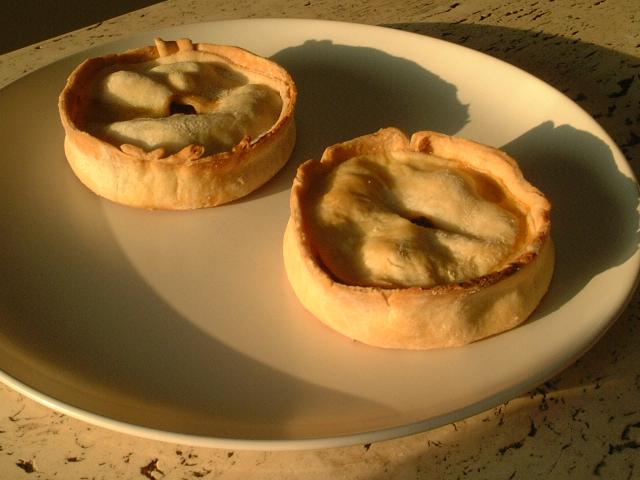
- made with very cheap but good halal mutton from an online South Asian supplier (Baticrom, for anyone in Japan), these worked out very well. The meat was "frozen leg slices" about an inch thick: the meat and fat balance made an authentic mince, and the pieces of bone just the right amount of well-flavoured stock to finish off the filling. I want a pie press !
Pork pies elsewhere on eGullet:
Making pie crust with boiling water
-
It's been a hilw since I was at Lawry's, and I've only been three or four times. I do remember the meat as being American-style, grain-finished beef. Maybe that's obvious to you already.
-
Hi, melonpan. My deep-frying rig is a black-finished cast iron pot/dutch oven (it has a matching lid). I keep oil in it and use it only for deep-frying.
This pot was originally a present, but we found that for stews, the black finish dissolved in the food - beef in red wine came back an ominous grey-maroon; even a straight beef & veggie number turned darkly ugly. For years this thing sat in cupboards; a couple of years back I got it out & attacked it on the inside with wet-and-dry or something of that sort - but the surface is kinda rough. In the end I thought it could earn its keep as deep-fryer and oil-storage, both.
There'll always be splash on the inside of the pan, and always the odd oil-run down the outside - like you, I found that even with very little deep-frying, a bright-metal pot will soon get pretty claggy. The black-finish cast iron disguises this nicely.
Cast iron isn't the best of conductors, but in deep frying you don't worry so much about an even heat over the base of the pan. As others have said, cast iron holds a lot of heat and so resists temperature drop when you immerse the food. The downside for me, is that it's hard to control the temperature. You can heat that sucker up till the oil's at 180C, but if you turn down the flame at that point it'll keep on getting hotter for several minutes. This you can learn how to handle. What's more difficult is getting a hang of gas adjustments for the different temperature drop of different foods and different volumes of food. That said, I don't want to throw out something with sentimental value, and my cast iron and I soldier on together. By now I have some feel for the constant flame needed to maintain temp, and I co-ordinate the 'heat overrun' with dropping the food in. I use one of those shabu-shabu foam skimmers both to move & remove food, and to clean up leftover crumbs. The flat pot lid makes a handy rest for it, turned over on the work surface by the stove.
Given a blank slate, my ideal would be:
A dedicated electric deep fryer, and the counter space for it - not like the 1100W (or was it 800?) Twinbird a friend bought - it barely had the oomph to heat up the oil, far less fry anything. On the other hand, a good deep fryer has the convenience of a resting position for the basket above the oil, and it's the only ready-made or easily-improvised solution that'll give you protection in the unlikely event that an earthquake coincides in your home with a vat of hot oil.
A dedicated deep pot and a basket that'll fit - use a deep pot and a shallower basket, so that the extra oil below the basket is your heat reservoir. This is what I recommended to my friend. At Mitaka J-Mart we found separately a deep 24cm aluminium pot, and a basket with a rim that nestled exactly on top of the pot rim. Single disadvantage - the basket handle doesn't fold for storage. Total cost was about 3,000yen or 4,000yen.
Are you actually in Japan ? The final option would be one of those containers you can buy here specifically for storing oil, and one of your existing pots. That oil-glaze may be ugly, but I'd argue it's not killing anyone, and second Fooey on "ugly pot ? So what ?".
-
That's for amateurs. The hardcore among us googled eGullet and reread past threads in Google's cache!
Pshaw ! The real hard core already read everything...
-
Yeah, but did you Google "eGullet" and find the Facebook page and keep going there looking for announcements, too ?
-
I love it when I hear the expression "I could care less". When I knew it, this was always "I couldn't care less". You know - "I could not care less" about something, as in, I care so little, it would be impossible to care less about it. I'm at the absolute zero of caring; I don't give a fig. I care not a jot or a tittle.
"I could care less" sounds like the opposite to me - "I could care less, so right now I'm caring to a certain extent. I care. It's important to me !" But that's not the sense it's used in. What is it, New York sarcasm or something ? You hear it from all over the States, and it sounds so peculiar. That said, I'm not expecting to wake up on some Vanilla Sky morning, and find that the world has turned and things have reverted just to suit me.
Sure, if I stand in the same position and take a series of shots with different lenses, the perspective - according to a strict technical definition - will be the same, but
"My wife's face; outdoors",
"My wife in the garden",
"My wife at the bottom of our garden", and
"My wife in our garden, which gives a panoramic view of the vast woodlands of Appalachia"
- are different subjects; and whether or not the technically-defined perspective is the same, you can't say that the different lenses don't give you a different perspective on what you can see from that place. Yes, it's good to understand the relationships between the various elements, and of course as you said, when it comes to viewing any given image, the size of the reproduction has a bearing on how we perceive it - if we blow a wide-angle shot up big enough (or print a zoom shot small enough), we can lose the distorted perspective.
Thanks to too long an association with Amazon.com, my apartment has enough books, thanks (makes sign of cross, brandishes garlic).
I've decided that I don't see (telephoto / zoom in) pincushioning in Holly's shot - I think there's only 'look-down distortion', if we can call it that - parallel vertical lines appearing to diverge as they come upwards, because we've angled the camera downwards relative to them - camera angle, as you said.
-
Yes, and I can remember Melton Mowbray pressure being exerted through television back in the 70's or early 80's. I do like that recipe - Leicestershire, Melton Mowbray - getting more and more parochial despite the advent of modern transport and communications ?!
I had to look up cob-nut - a hazelnut or kind of hazelnut, it says here.
Assembly & baking
"Roll out pastry, cut a circle for the case (~21cm for 10cm pie ring), and a lid using the ring. Make a case in the pie ring, fill, brush edge with egg, cover with lid, press seal and crimp with fork. Wrap with single-layer ring of baking paper, fixed with a paper clip on a stub of the overlap, folded up."
As above, and:
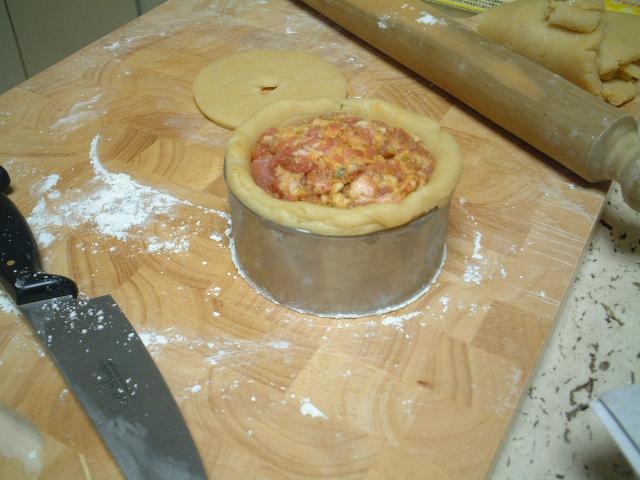
I picked up the pastry-cutter idea a while ago, from a video on Youtube about making Scotch Pies. I couldn't find it again - I think it's been deleted. It's more trouble than I'd imagined, though - wrestling the extra folds of pastry into a uniform pie-shell-side takes some effort. I did get a good shape in the end. And where a pie *tin* would give trouble getting the case out, using a ring like this, you just upend it and the pie slides gratifyingly out of into your waiting hand.
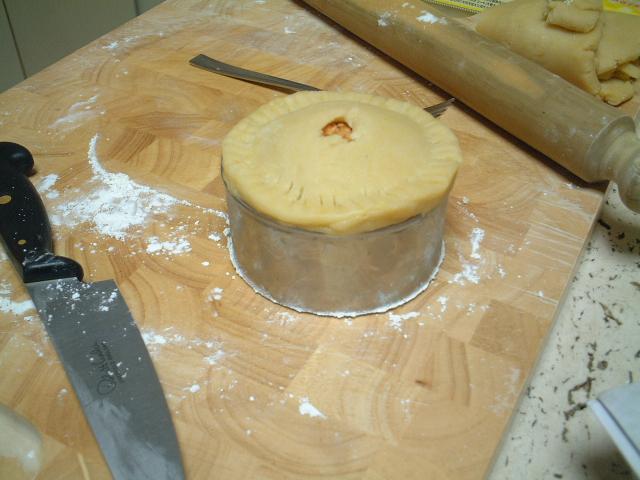
"
Allow to stand for an hour (in fridge if possible) for seal to cure. Preheat oven to 200C. Line tray with baking paper and bake for 30 minutes, turning tray round once. Turn again and bake at 170C for 1.5 hours (no turning round needed).
Remove paper rings, brush with beaten egg and bake for 10 mins further at 190C, turning round once.
(*** For non-paper-wrapped, egg wash to start, and first 30 mins at 220C then bake out at 170C, works well)
"
In the oven:

- by this time of night, in June with a hot oven, you'd have your shirt off, too. Specially notable in this shot is the 1980's-vintage, bright green vacuum cleaner, bottom right, followed closely by the 2000-vintage NTT docomo mobile phone.
I suspect I baked these too long. I'm resolved to use my cooking thermometer next time to call a halt by temperature. That said, the pies weren't noticeably impaired in the eating - perhaps they retained just a little less fat than ideal.
Nor did these five pies account for the whole of the mixture - I still had plenty of meat left, but as Bob Seger said, "I know it's late, I know you're weary". That batch of all-cake-flour pastry hove once again into the view of mind's eye - I *did* give it a machine-kneading, after all, and what was a pie case originally, anyway, if not a handy disposable meat container ?
Haunted by visions of middle-school pottery, I fired up my trusty fist and shaped the ball of weak-flour-paste around it freehand, finally setting it on the workboard and working the sides up to get:
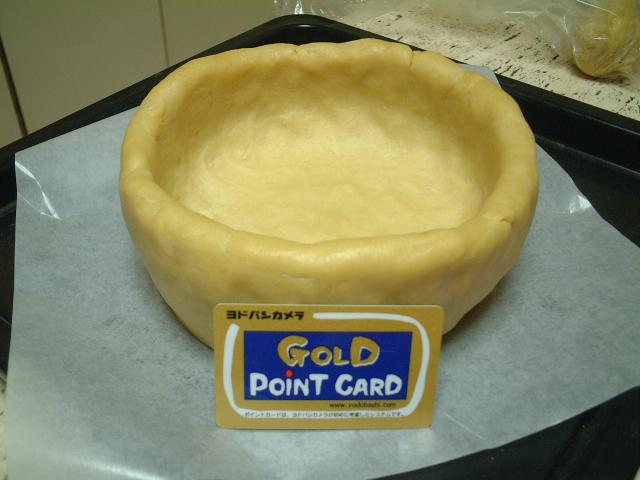
(Yodobashi camera gold (gasp !) point card - credit card size - shown for scale).
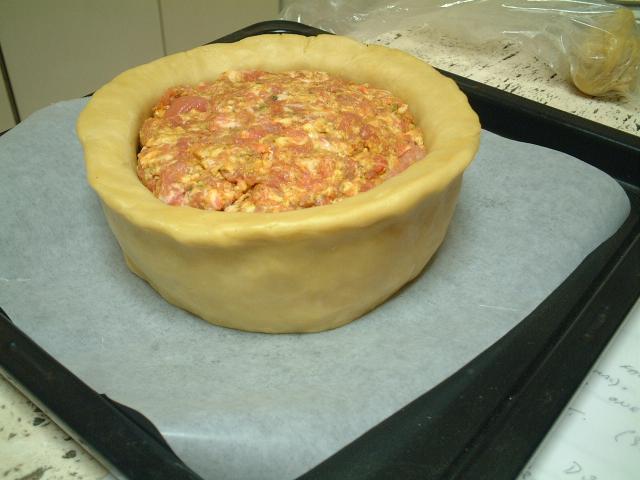
I formed the lid from some of the 'all-purpose' flour pastry batch, and made dirty great flutes with my thumb:

It's you & me, pie-face. "We've got Tonight".
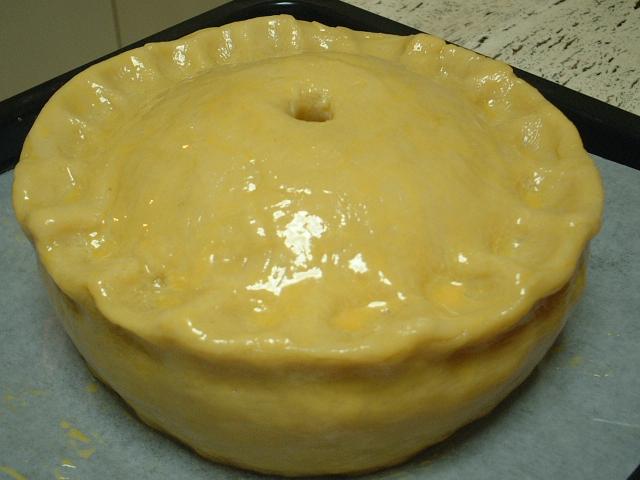
Next: results
-
I can assure you that I'm using 'subject' to mean the same object, *filling the frame the same amount*

Your perspective on the words is a purists' one, and everything you say about perspective depending purely on distance is correct and consistent within itself. Yes, to the extent that you have resolution, you can shoot with any length of lens (if you shoot in the right direction) and crop to get the same image. But that's not how we photograph, practically, is it ? Generally - certainly with food - we have a specific subject we want to portray. A news photographer will depend daily on cropping from a wide image. Food doesn't move, though. and while there's certainly advantage in shooting somewhat larger than you need, I believe you can get pretty close to the image you want, in the frame you shoot.
A portrait lens lets you back off from the subject so that the subject can feel more relaxed - partly because it lets you see what you're shooting properly in the viewfinder despite being that far away, doesn't it ?
I sympathise with what you say about "a common misconception about perspective and focal length", but even my venerable textbook The Joy of Photography refers to the different perspective that different lenses give. Actually this is a fun conversation and it's been strangely satisfying to be driven to dig the old tome out again.
Coming back to the topic - in the end, I think you're right that perspective 'distortion' is not the problem with Holly's picture. (I do think that filling the frame more with the food and plate, would make it easier to compose a good image in the first place, and to review it on the spot, on the in-camera display).
Looking again more closely, it seems the angle of the light, the shape of the plate, the shape of the food, and the light's single direction conspire to make the plate feel like it's bleeding off to the bottom left.
As far as I can like the picture, if we're determined to keep the plate, I like it rotated - 2 degrees clockwise, here. A bit too much ? Also lightened two steps and sharpened, as others did, and with a little more yellow:
-
Well that's a nice coincidence. Just last night we had a juicy half of a honeydew melon. It struck me how long it's been since I had 'powdered ginger on melon', which back in the 70's seemed like quite the thing.
I don't keep the powder any more. I minced up an inch of ginger on the chopping board and put it in a (large-ish) bowl with about 3 tbsp of honey. 2 - 3 minutes in the microwave (600W) and it made a very tasy dressing for the fruit. You can turn honey more or less caramelised, quite quickly in the microwave. As with caramel over the stove, it can burn if overdone.
-
No, it's just subject distance. To put it another way, say you were to take a portrait from six feet away using a 35mm camera with a 28mm lens and an 85mm lens, and then you cropped the photo made with the 28mm lens and printed both to the same size with the subject the same size--perspective rendition would be the same in both photographs.
Clearly we've used the word 'subject' differently. In my usage, the same thing in the same framing; in yours, a landscape is the same subject as an individual standing in the middle of it
 - the same goes for the big-nose, 'fishbowl' cabbage-patch-doll-look situation.
- the same goes for the big-nose, 'fishbowl' cabbage-patch-doll-look situation.Just to be clear on terminology, "perspective" in this context refers to the relative size of objects in the frame...
yes, and the spaces between them, but we're both talking about the same thing, illustrated for example here (1/3 of the way down the page) - focal length and perspective
... We tend to think of it as "distortion" when it looks unnaturalSo I guess my first reaction when I saw Holly's original shot was "has the perspective been distorted by using too wide-angle a focal length for the distance ?". There's not much in it, and the backlighting / unfortunate lighting and complete loss of definition in so much of the front of the plate rim don't help, but at any rate it looks strange. I wondered if that's what made it so hard to crop.
-
Montreal... will French stuff not work in your place ? A good pate maison / terrine will always appeal as something that shows some effort, and it pushes work out of service hours.
You could ride the Julie & Julia craze with coq au vin, for a season at least: ditto on the same two counts.
-
I use an old point-and-shoot digital compact, a Fujifilm Finepix 4500, and I'm an average photographer at best. I just re-checked with the same plate I have in the photo I posted (that's a big 30cm / 12" plate), and I framed that picture in macro mode at max zoom (of course that's all-digital macro & zoom) at a range of 35cm from the centre of the plate. A D90 would still focus down to that distance even with the 17-35mm lens, though the front of the plate would be out of focus (min focusing distance 28cm).
Philadining, yes, it's all about compromise, isn't it ? I did have the luxury of standing up and moving around my subject. I was lucky that the lighting wasn't too bad (under the kitchen's incandescent spots and ambient fluorescent), my camera automatically adjusts white balance, and I took two or three pictures. I don't think I used a tripod that time - the photo above I'm pretty sure used synchro flash. (Within the camera-shake rule of thumb or not, goodness knows I've spoiled enough pictures through not holding the camera steady).
David Goldfarb, I always appreciate your knowledgeable posts, both on kitchenwork and camerawork... by which form of words, you can just tell I'm going to take issue with something you said
 ... perspective distortion isn't caused by focal length but by the distance between the lens and the subject
... perspective distortion isn't caused by focal length but by the distance between the lens and the subjectLet's say I decide to take your portrait, so that the portrait shows your head, neck and a bit of your collar area, and some space around - a portrait that fills the frame. Standard technique says we do this standing maybe 8 - 10ft away, with an 80 or 85mm lens (35mm film). I could take the same portrait, that is fill the frame with the same amount of your image, by using a normal / 50mm) lens from, what, 4 or 5ft ? Or from closer still with a traditional wide (35mm) lens. However, each picture would look different - show a different perspective - with you beginning to look distinctly cabbage-patchy at 35mm. I don't know at what point one begins to call the difference in perspective 'perspective distortion'.
Which is a long way of saying, you're right of course, but, nitpicking, don't we say that, perspective distortion is caused by a combination of the distance between the lens and the subject, and the focal length of the lens ?
-
Thanks, Adam. You're right about Melton Mowbray pork pies, of course. Isn't it funny how now, under Europe's stewardship, they're to have a protected origin that they never enjoyed under the UK's ? Funny how the world turns, but yes, 'generic' is more to the point than my choice of word, 'commercial'. We'll come to the taste description presently

Pastry / Hot water crust
The bad news is, I forgot to take any pictures of the pastry making till I'd made a batch of pastry and it was already resting in the fridge.
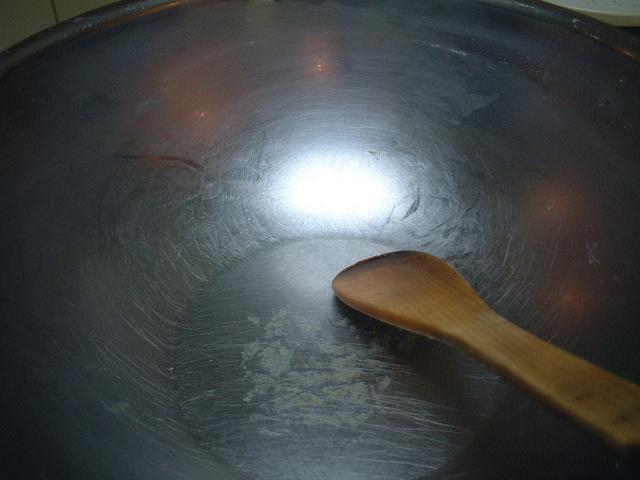
I struggled with whether to follow the no-egg recipes or the recipe with eggs. I cut back on the amount of fat & eggs in Bernard Hall's recipe, but left in some egg, if for no other reason the price of butter round here. The formula I settled on was:
(can prepare in advance and keep refrigerated)
900g flour
100g lard
100g butter
1.5tsp salt (reduce slightly if using wet mustard ?)
200ml water
2 eggs
1tbsp of mustard powder or wet mustard (I used wet)
1(.5 ?) egg beaten for sealing the case and glazing
In a bowl, (mix in the mustard if powder, and) create a well in the flour, break in the eggs (and add mustard if wet), and stir them into and then through the flour using a knife or fork.
Put the lard, butter and salt into a saucepan with 3/4 of the water and gently heat until the fats are melted. Do not allow to boil (it leaps out of the pan !)
Make a hollow in the flour mix, add the melted fats, mix in and start adding the rest of the water little by little as needed, stopping when the dough comes together in a ball (I used 200ml at first and it was ample, maybe too much). When it is thoroughly mixed it should not be greasy but a firm dough. If it appears greasy add a little more flour and knead some more until it feels non greasy.
My notes say to wrap the dough and rest in the fridge for at least 2 - 3 hours, and that it'll take 1/4 - 1/3 of the pastry to make lids.
Now, 900g of flour is all very well, but there's no such thing as all-purpose flour in Japan. There's strong and there's weak. What I did in the first place, was decide that, since I was going to get to choose, I'd use all cake flour (don't laugh), and give it a work-out in the breadmaker to develop as much gluten as it had. Tender, I reckoned. I mixed up the batch and in the end added another 200g of flour at the "if it's greasy" stage. The machine kneaded it to a lovely glossiness.
It was as i stood looking into that empty mixing bowl, that a memory came back to me from last summer, when I was working with shortcrust and had gone through a similar thought process. I ended up with Forfar bridies / meat turnovers featuring a crust that was like eating warm fat bulked out with Polyfilla (household filler). So, the good news is that in a panic I set the all-cake-flour hot water crust aside and made up a new batch, 1/3 cake flour and 2/3 strong flour, more like a standard all-purpose flour ratio. Seen here with the egg and mustard mixed in, ready to add the hot liquid:

I didn't have much bandwidth (or hands !) available for taking pictures anyway. I kneaded this batch briefly by hand only. Which gave:
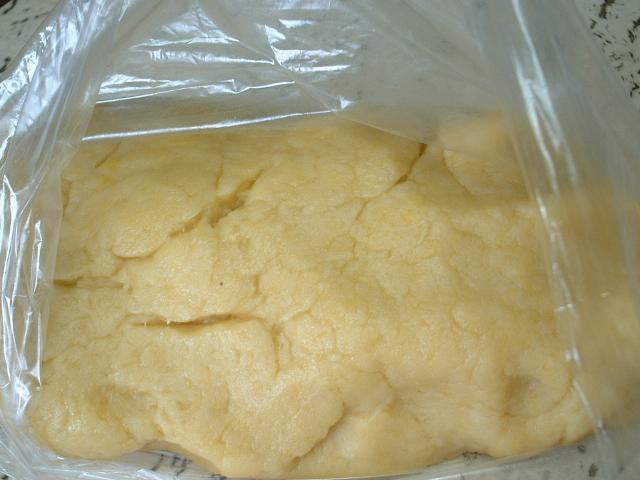
After a couple of hours rest for the pastry, I was ready to roll:
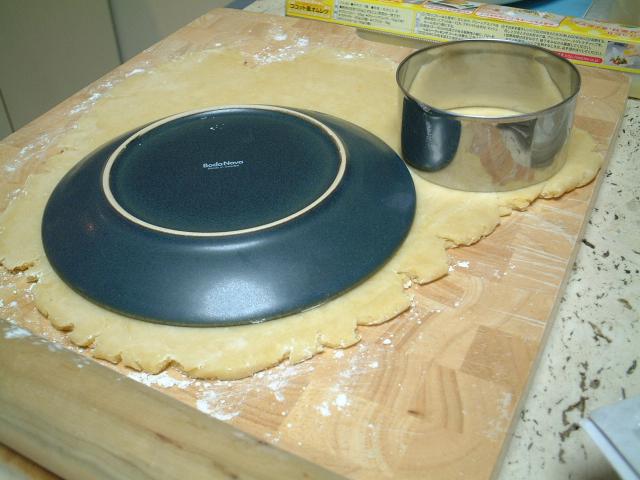
- placed on the pastry here you can see a round pastry cutter that's 10cm / 4" across and 4.6cm / mumble" high, and a plate that's nicely about the same width as the cutter + (2 x the cutter's height), with about 2cm extra. A rolling pin lurks in the foreground.
-
I finally decided to have a go at making raised (hot water crust) pork pies. These are something of a British staple, and always eaten cold. I took my inspiration from the first resource I ever found on the internet, some years ago, for these, at Bernard Hall's site as well as a recipe at metfieldbakery.com (it seems the link is no longer active), and some reference to Jane Grigson's 'Good Things'.
Seems I'm kinda slow to action and I've kept up the theme by not making the time to do a write-up till now, since making the pies in June

Anyway,
I started with the pig-trotter stock for the jelly that eventually fills the space between filling and crust:
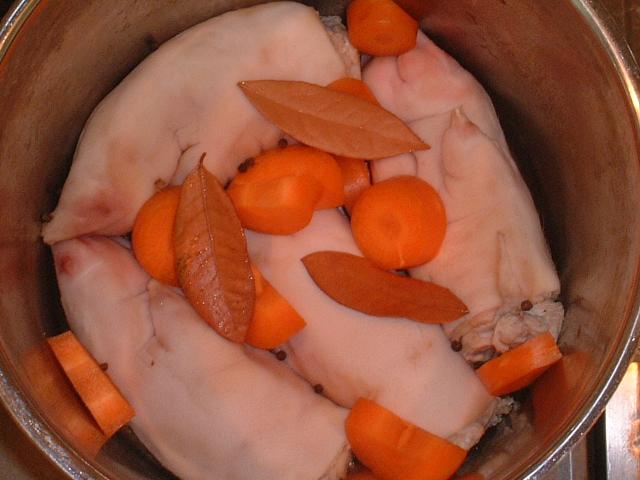
- I used 4 trotters, 3 bay leaves, 1 carrot, 20-odd peppercorns, and a sprig of thyme. Trotters in a single layer - covered with water, plus about an inch depth. Bring to boil & simmer for 4.5 hours, turning every hour or so.

Later it looked like this:
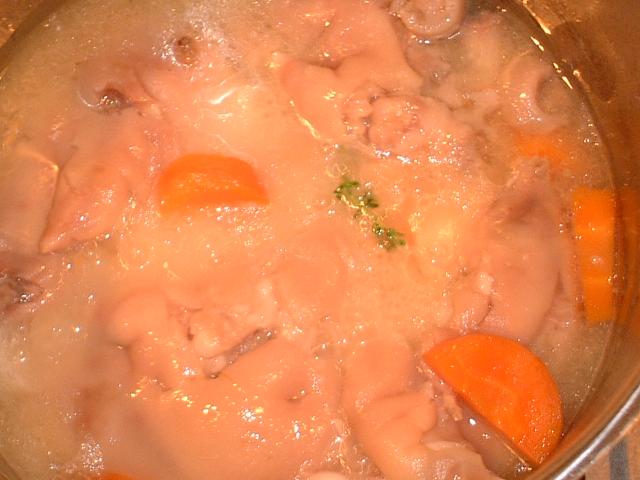
Finally, I did my best to clarify the stock using egg whites, with mixed results - more of which anon.
Filling - mostly following Bernard Hall, but with a couple of adjustments, some out of necessity, some by choice. I included some turmeric as an emulsifier for the fat, and to see what sort of contribution it'd make to colour. Commercial pork pies use nitrate/nitrite which keeps the meat pink as well as aiding preservation.
(all pork rindless)
0.5kg pork loin
0.5kg pork shoulder
0.5kg pork belly
1/4 nutmeg
3 cloves
4 berries allspice
1.5tsp black peppercorns
1.5tsp white peppercorns
1 small dried red chilli
2.25 tsp salt (sekka-en)
2tsp paprika
2tsp turmeric
1tsp dried sage
1.5tsp fresh thyme leaves, unpacked volume
1tbsp lemon juice & 1tbsp white wine vinegar
The whole spices for grinding:
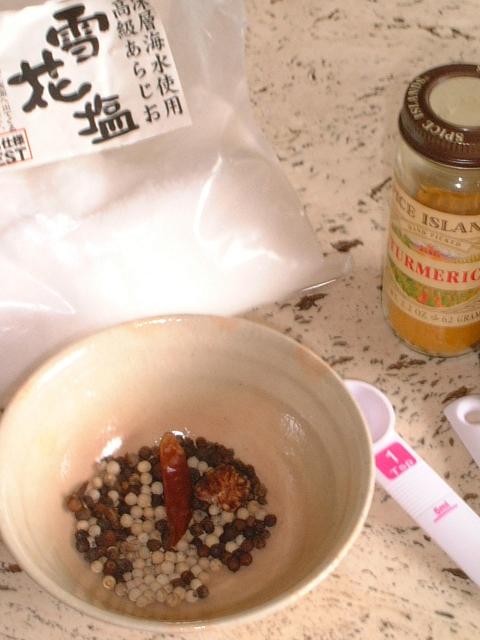
In the background is the bag of 'sekka-en' salt, "high quality coarse sea salt" the label on the front says; on the back is 'product of China'. I hope I pronounce it right as 'sekka-en' in Japanese - it means "snow flower salt". Aww.
Salt & herbs / spices that don't need ground:

I got the grinder & tray ready to scald with boiling water:
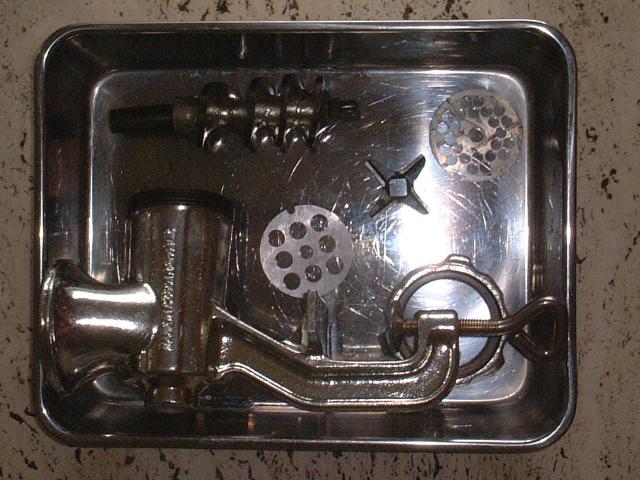
...chilled and set it up ...
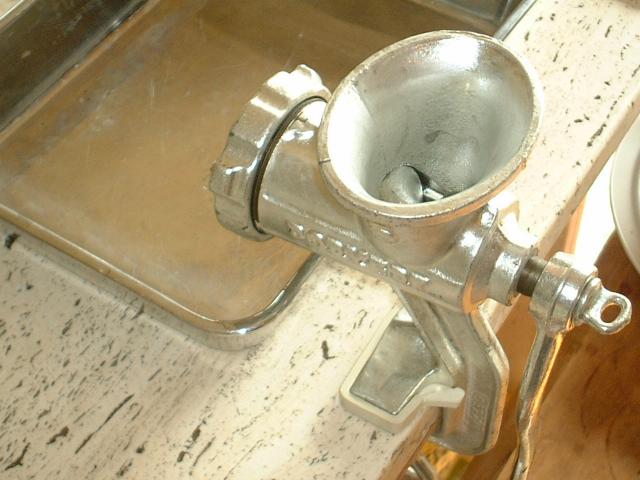
...and got grinding. I cut the lean eye out of the pork loin, cubed it and held it aside. The rest of the meat went through the 10mm grinder plate, then half of the belly mince made a second pass through the 6mm plate. I think I started with the remainder of the loin:
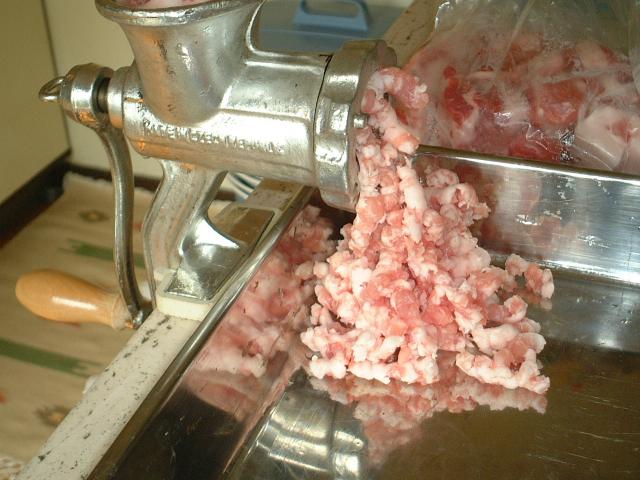
...then the shoulder ...
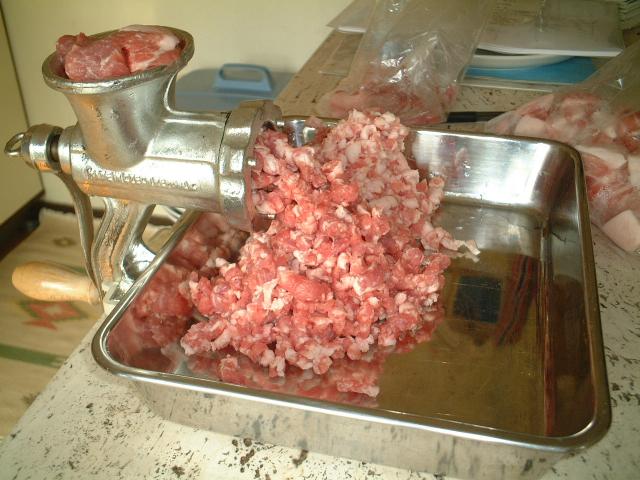
...then the belly

(in a standard Japanese apartment it's compulsory to have piles of documents on the kitchen / dining / office table).

That just left the mixing:
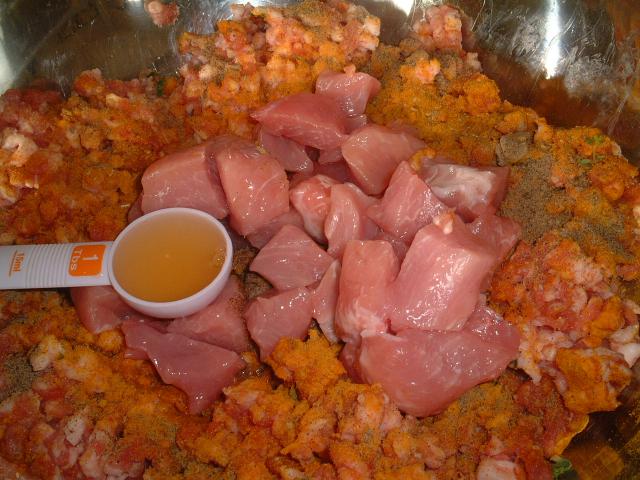

...and reserving for a couple of hours (2 - 24 should be OK). This mixture seemed highly seasoned in the bowl, and when fried-and-tried, but turned out just right in the finished cold pie.
Next: pastry, assembly, baking.
-
Just to be sure, i looked up the 17-35mm lens for the D90, and it is indeed equivalent to roughly 28mm-55mm on a 35mm film SLR.
I still think that's short for photographing food, and I'll ask my original question again, are you happy with the perspective in your shot ? To me it looks like you've shot it with the zoom out noticeably from a 'normal lens' position. The plate's not only big and white, it's being distorted to look just slightly convex, and that's more distracting than a big, white plate shown with a normal perspective. Am I wrong ?
Also noting the apparent motion-blur: what is the minimum distance from which you can use that lens, and still maintain focus ? Were you far enough away from the subject ? I can't pick out any distance here (looking at the tabletop, for example) that's really in focus. You'll not generally get camera shake with a shutter speed of (1 / focal length, i.e. here 1/55, maximum), or faster. What shutter speed was the image taken at ?
As a general question to the experts here, am I wrong to think that this lens (barely longer than a normal lens at its highest zoom) is not the best for food photography ?
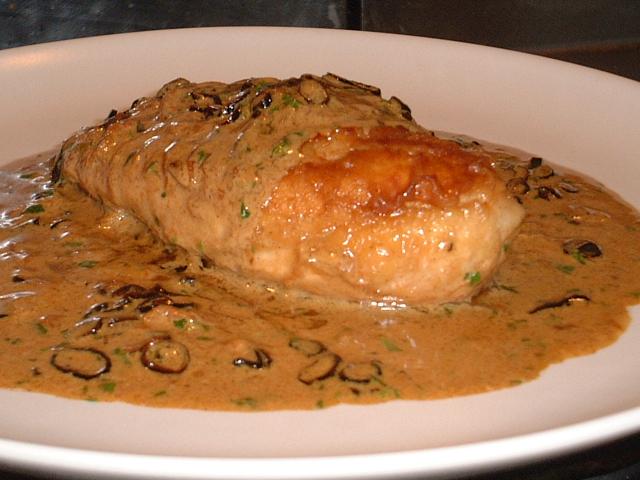



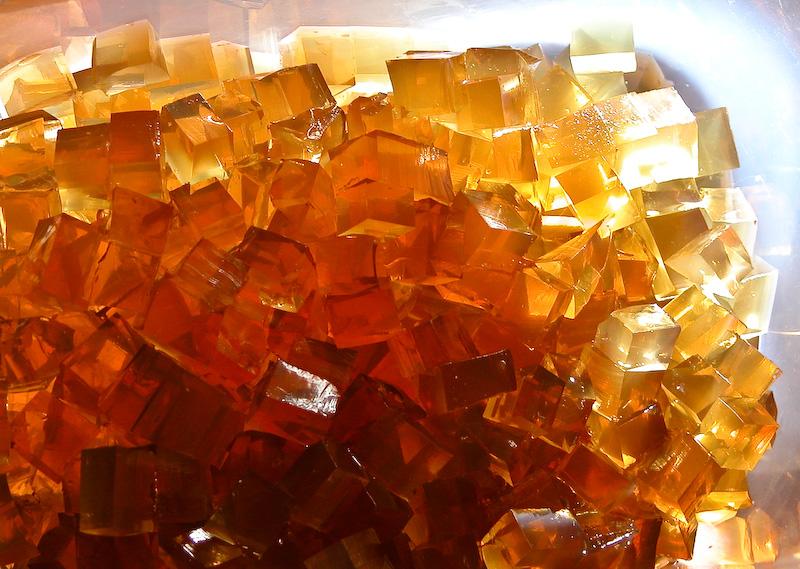
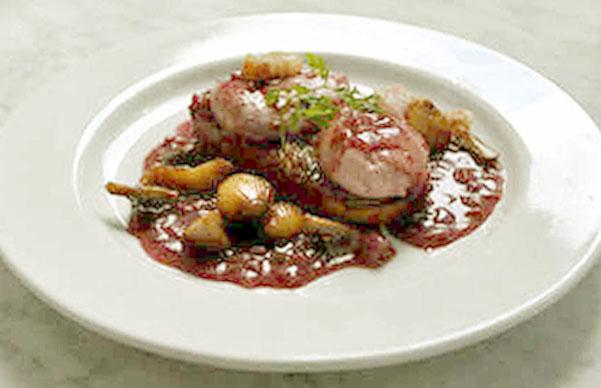
Japanese foods-- Okashi
in Japan: Cooking & Baking
Posted
In my house the Koreans have it, and Ghana is king.